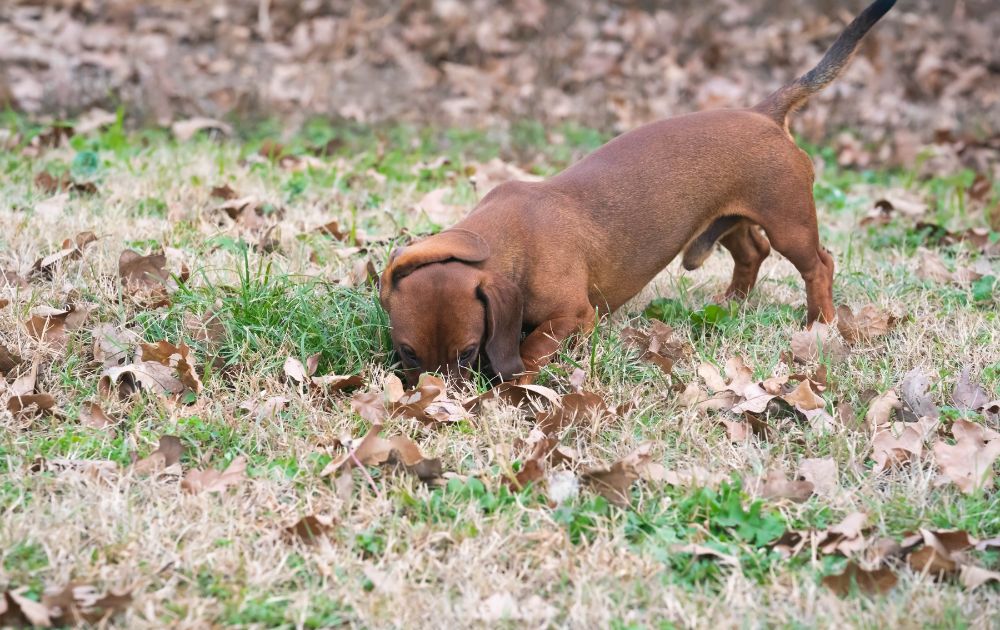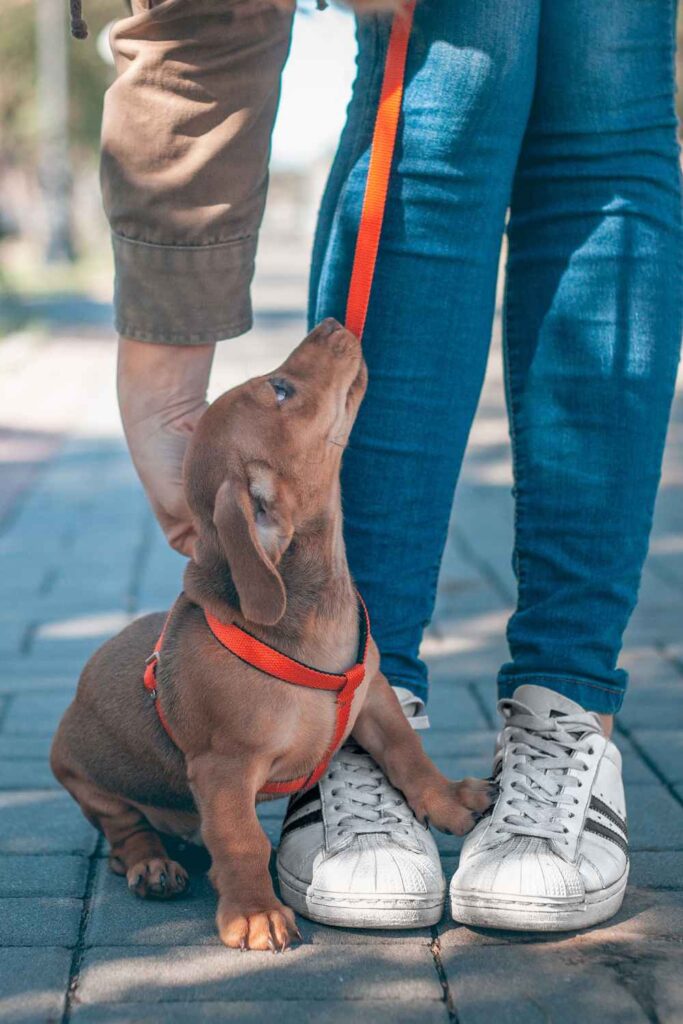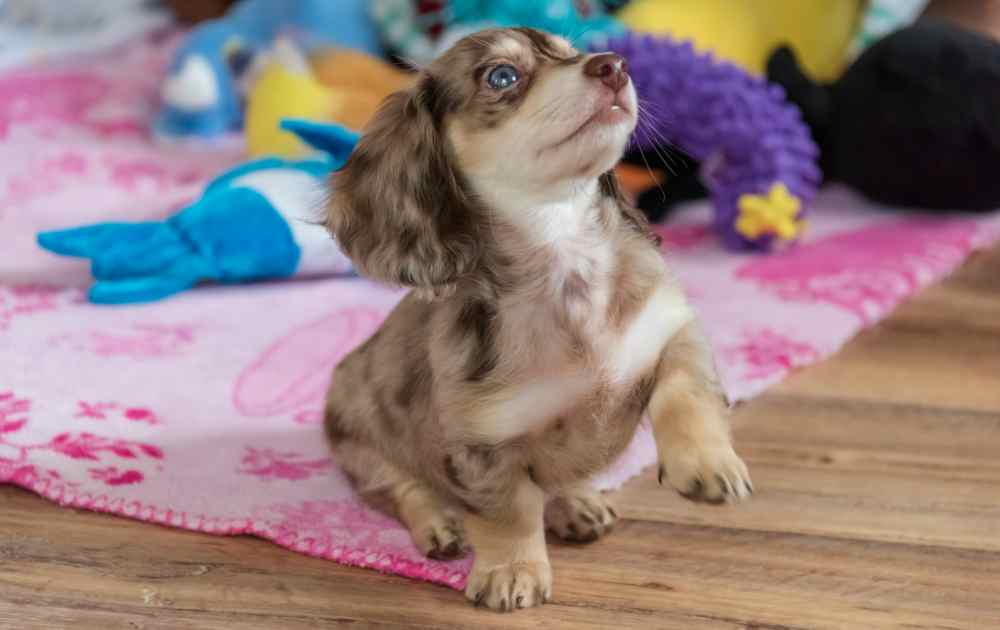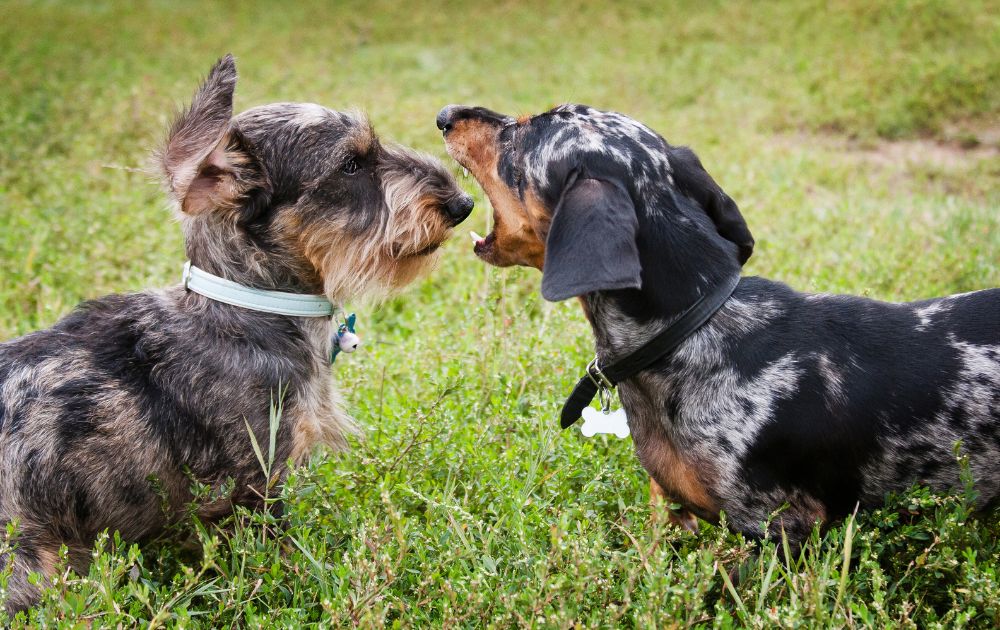Bringing a Dachshund puppy home is an absolute thrill! These little cuties with their adorable looks and charming personalities have a way of stealing our hearts in an instant.
But as much as we adore them, it’s crucial to invest time and effort into their training to ensure they grow up to be well-behaved, sociable, and content companions.
In this guide, we’ll provide you with some training tips that will set you and your Dachshund puppy up for success. Whether you’re a newbie to the doggy world or a seasoned dog enthusiast, we’ve got the keys to help you successfully train your little wiener dog.
So, get ready to embark on an exciting journey of understanding Dachshund puppies and establishing a solid training foundation. Let’s dive in and unlock the secrets of a well-trained and happy Dachshund companion!
Understanding Dachshund Puppies
Dachshund puppies are an irresistible combination of charm, curiosity, and boundless energy. Understanding their unique traits is essential when it comes to training and raising them into well-rounded adult dogs.

Here are some key insights into the world of Dachshund puppies:
Temperament:
Dachshunds are known for their bold and tenacious nature. They are often fearless, despite their small stature. This can sometimes translate into stubbornness during training, requiring a patient and consistent approach.
Socialization:
Dachshunds are generally friendly and affectionate dogs, but early socialization is crucial to ensure they develop good manners and interact positively with other animals and people. Introduce your Dachshund puppy to various environments, people, and animals to foster their social skills and prevent shyness or aggression later on.
Energy Levels:
Dachshund puppies have a surprising amount of energy packed into their tiny bodies. They enjoy daily playtime, mental stimulation, and exercise to prevent boredom and destructive behaviors. Providing them with structured activities and engaging toys will help positively channel their energy.
Hunting Instincts:
Originally bred as hunting dogs, Dachshunds have a strong prey drive. This can manifest in behaviors such as chasing small animals, digging, or excessive barking. It’s important to provide alternative outlets for their instincts and train them to redirect their focus to more appropriate activities.
Separation Anxiety:
Dachshunds are known to form strong bonds with their owners, which sometimes leads to separation anxiety when left alone. Gradually acclimating your puppy to being alone, using positive reinforcement and crate training, can help alleviate this issue and promote independence.
Understanding these aspects of Dachshund puppy behavior is like unlocking the secret code to successful training. With this knowledge in your back pocket, you’ll be able to customize your training methods to cater to their specific needs, giving them the guidance and structure they require to flourish.
Always keep in mind that a well-trained and socialized Dachshund puppy will blossom into a well-rounded and content companion that will bring you joy for many years ahead.

Addressing Specific Dachshund Traits
Dealing with Stubbornness and Independence
Ah, Dachshunds and their independent streak! These little sausages can definitely be a tad stubborn at times, which can make training a bit of a challenge.
When it comes to training your Dachshund, patience is your secret weapon. Stay calm, cool, and collected, even when they’re testing your limits. Consistency is key too. Stick to your training routine and never give up on them.
The well-known secret for success: positive reinforcement! It’s like magic for Dachshund training. Keep your training sessions short and snappy to hold their attention. Break down commands into bite-sized pieces, rewarding your little hot dog with treats and praise for each successful step. By appealing to their clever minds and providing enticing incentives, you’ll have them wagging their tail and eagerly participating in training exercises.
Remember, a sprinkle of patience, a dash of consistency, and a whole lot of positive reinforcement can work wonders with your stubborn but oh-so-lovable Dachshund.
Managing their Strong Hunting Instincts
Dachshunds were originally bred as hunting dogs, known for their ability to track and flush out small game. As mentioned above, this innate hunting instinct can manifest itself in behaviors such as chasing small animals or digging. To manage these instincts, it’s crucial to provide alternative outlets for their energy and mental stimulation. Engage your Dachshund puppy in interactive play sessions, provide puzzle toys or treat-dispensing toys, and consider participating in activities like scent work or agility training. Redirecting their instincts towards more appropriate activities will help satisfy their natural drive and prevent unwanted behaviors.

Discouraging Excessive Barking and Digging
Dachshunds tend to be vocal and may bark more frequently than other breeds. Excessive barking can become a nuisance if not properly addressed. Teach your Dachshund puppy the “quiet” command by rewarding moments of silence and redirecting their attention to more appropriate behaviors. Additionally, ensuring they receive sufficient mental and physical exercise can help reduce their need to bark out of boredom or frustration.
Digging is another behavior that may surface in Dachshund puppies. While some degree of digging is natural for many dogs, excessive digging can damage your yard or garden. Provide designated digging areas, such as a sandbox or a specific spot in the yard, where your Dachshund can fulfil their digging instincts. Encourage and reward digging in these designated areas while redirecting them away from areas where digging is not permitted.
Avoiding Separation Anxiety
We’ve already mentioned that Dachshunds form strong bonds with their owners and can be prone to separation anxiety when left alone for extended periods. Gradual desensitization to being alone can help alleviate separation anxiety. Start by leaving your puppy alone for short periods, and gradually increase the duration over time. Create a positive association with being alone by leaving them with stimulating toys, treats, or puzzle games. Additionally, crate training can provide a safe and comforting space for your Dachshund puppy when you’re not home. A crate acts as a den-like environment where they can feel secure and relaxed in your absence.
By tackling these unique Dachshund traits head-on with a big dose of patience, understanding, and consistent training, you’re setting the stage for your puppy to blossom into a well-behaved and balanced adult dog. It’s all about nurturing their natural instincts and shaping their behavior in a positive way.
Keep the power of positive reinforcement at the forefront of your training journey. Reward good behavior with treats, praise, and plenty of love. This approach will not only motivate your Dachshund but also strengthen the bond between you two.
Remember to provide outlets for their instincts. Whether it’s designated digging areas, interactive toys, or engaging in activities that stimulate their mind and body, catering to their needs is essential for a happy and fulfilled Dachshund.

Basic Training Techniques
Establishing a Positive and Consistent Routine
Creating a structured and consistent routine is essential when training a Dachshund puppy.
Dogs thrive on predictability, so establish regular mealtimes, play sessions, exercise periods, and designated potty breaks. This routine helps them understand what is expected of them and reduces confusion or anxiety. Consistency in your training methods and commands is also crucial. Use the same cues and gestures for each command, and ensure that all family members are on the same page to avoid confusion.
Socialization: Introducing Your Dachshund Puppy to New Experiences
Early socialization plays a vital role in shaping your Dachshund puppy’s behavior and temperament.
Expose them to various people, animals, sounds, and environments from a young age. Gradually introduce them to new experiences, such as walks in different neighborhoods, visits to parks, and interactions with other friendly dogs. This exposure helps them become confident, well-adjusted, and comfortable in various situations, reducing the likelihood of fear or aggression later in life.
Housebreaking: Potty Training Your Dachshund Puppy
Housebreaking, or potty training, is an essential aspect of training your Dachshund puppy. Establish a designated potty area outdoors and take your puppy there regularly, especially after meals, naps, and playtime. Use verbal cues, such as “Go potty,” to associate the action with the command. When accidents happen indoors, remain patient and avoid punishment. Instead, redirect them to the appropriate spot and reward them when they use it. Consistency, positive reinforcement, and close supervision are key to successful housebreaking.
Crate Training: Creating a Safe and Comfortable Den for Your Puppy
Crate training provides a safe and comfortable space for your Dachshund puppy, mimicking the den-like environment they naturally seek. Introduce the crate gradually, making it a positive and inviting space. Place soft bedding, toys, and treats inside to encourage them to enter willingly. Start with short periods of confinement and gradually increase the duration, always ensuring that the crate is associated with positive experiences. This training not only helps with housebreaking but also provides a secure place for your puppy when you’re unable to supervise them.

Teaching Basic Commands: Sit, Stay, Come, and More
Teaching basic commands is fundamental to building a well-behaved and obedient Dachshund puppy. Begin with simple commands like “sit,” “stay,” and “come.” Use treats or rewards to motivate and reinforce the desired behavior. Break down the commands into small steps, gradually adding distractions and increasing the difficulty level. Be patient, consistent, and always end training sessions on a positive note. Remember to keep training sessions short and engaging to maintain your puppy’s focus and enthusiasm.
These basic training techniques are like building blocks for your Dachshund puppy’s development. They lay the foundation for a well-behaved and happy little sausage dog. By incorporating positive reinforcement, consistency, and heaps of patience, you’re setting your pup up for success.
Advanced Training and Tricks
As your Dachshund puppy grows and masters the basics, you can progress to more advanced training techniques and teach them impressive tricks. Advanced training not only challenges your puppy mentally but also deepens the bond between you and your furry companion. Here are some ideas for advanced training and tricks:
Leash Training and Loose-Leash Walking
Leash training is an important skill for any dog. Teach your Dachshund puppy to walk calmly on a leash without pulling or lunging. Start in a quiet environment and use positive reinforcement when they walk beside you without tension on the leash. Gradually increase distractions and practice in different settings. Remember to reward good behavior consistently and be patient, as it may take time for your Dachshund to master loose-leash walking.
Advanced Commands: Heel, Leave It, Drop It, etc.
Building on the basic commands, you can introduce more advanced commands to challenge your Dachshund’s skills. Teach them commands such as “heel” (walking calmly beside you), “leave it” (ignoring an object or food on the ground), “drop it” (releasing an item from their mouth), and “wait” (staying in place until given a release cue). These commands enhance your dog’s impulse control and responsiveness, contributing to their overall obedience.

Fun Tricks to Keep Your Dachshund Mentally Stimulated
Teaching your Dachshund puppy fun and mentally stimulating tricks is a great way to keep their mind sharp and provide entertainment. Tricks like “roll over,” “spin,” “play dead,” “speak,” or “fetch” are excellent options. To ensure success, use positive reinforcement, break down each trick into manageable steps, and reward your puppy’s progress. Keep training sessions short, enjoyable, and filled with praise and treats to maintain their enthusiasm.
Agility Training
Did you know that Dachshunds can do well in agility training despite their short legs? You can set up a mini-agility course in your backyard or enroll in a local agility class specifically for small dogs. It’s important to teach your Dachshund how to navigate tunnels, weave through poles, jump over hurdles, and maneuver through obstacles. This type of training is not only great for physical exercise, but it also helps challenge your Dachshund’s problem-solving skills and coordination.
Advanced Recall Training
Recall training is crucial for your Dachshund’s safety and allows them the freedom to explore while still responding to your call. Practice recall in a controlled environment, gradually increasing distractions.
Use high-value treats or toys as rewards for coming when called. Advanced recall training can include distance work, where you call your Dachshund from a greater distance and reinforce their response with praise and treats.
Remember to approach advanced training and tricks with patience, positivity, and consistency.
Break down each skill or trick into smaller, manageable steps, and celebrate your Dachshund’s progress along the way. Advanced training not only provides mental stimulation but also strengthens the bond between you and your Dachshund, creating a fulfilling and enriching partnership.

Importance of Positive Reinforcement and Rewards in Dachshunds’ Training
Using positive reinforcement is an effective training approach for Dachshund puppies.
This method involves rewarding desired behaviors to encourage their repetition in the future. By prioritizing positive reinforcement, you can create a pleasant and enjoyable training environment for your furry friend, which can help foster a strong bond between you and your Dachshund. Here are some essential factors to consider when using positive reinforcement:
Treats:
Food treats are often the most commonly used rewards in training. Choose small, soft treats that your Dachshund can easily consume and that they find highly motivating. When your puppy performs a desired behavior, such as sitting or staying, immediately offer them a treat and praise them enthusiastically. Treats should be given promptly after the behavior to ensure your puppy associates the reward with the correct action.
Verbal Praise:
Verbal praise is an important component of positive reinforcement. Use an enthusiastic and happy tone of voice to convey your satisfaction and approval. Say phrases like “Good job!” or “Well done!” to let your Dachshund know they’ve done something right. Verbal praise can be combined with physical affection, such as gentle petting or a belly rub, to reinforce positive behavior.
Play and Toys:
Playtime can be a powerful motivator for Dachshund puppies. Incorporate interactive play sessions and incorporate their favorite toys as rewards for good behavior. After a successful training session or when your puppy accomplishes a trick, engage in a fun play session with their favorite toy. This not only reinforces their positive behavior but also provides them with mental and physical stimulation.
Timing and Consistency:
Timing is crucial when using positive reinforcement. Ensure that you deliver the reward immediately after your Dachshund performs the desired behavior. This helps them make the connection between the behavior and the reward. Additionally, be consistent in your use of rewards. Always reward the behavior you want to encourage and avoid unintentionally reinforcing undesired behaviors.
Gradual Fade-out of Treats:
While treats are effective during the initial stages of training, it’s important to gradually reduce their frequency and dependence on treats. As your Dachshund becomes more proficient in a behavior, intermittently reward them with treats while gradually phasing them out. Eventually, transition to verbal praise and other forms of rewards, reinforcing the behavior without relying solely on treats.
Positive reinforcement is the name of the game when it comes to training your Dachshund.
Treats, praise, playtime, and toys are the secret weapons that make your puppy wag their tail and eagerly learn new tricks. Remember to shower them with treats and affection whenever they nail a command or show good behavior. Trust me, they’ll be begging for more!

Puppy Training Challenges
Training a Dachshund puppy can sometimes come with challenges and obstacles for the owner.
However, with a problem-solving mindset and a patient approach, you can overcome these hurdles and continue to make progress in training.
Here are some common issues that may arise and strategies to troubleshoot them:
Potty Training Regression:
If your Dachshund puppy starts having accidents indoors after making progress with potty training, it may indicate a regression. Review your consistency in taking them to their designated potty area, ensure you’re following a regular schedule, and reinforce positive behavior with rewards and praise. Consider going back to basics with more frequent potty breaks and closely monitoring your puppy for signs they need to eliminate.
Distraction and Lack of Focus:
Dachshunds, like many puppies, can easily get distracted during training sessions. If your puppy struggles to maintain focus, minimize distractions in the training environment and gradually increase them as their skills improve. Keep training sessions short and engaging, incorporating play and rewards to maintain their interest. Break down complex tasks into smaller steps and celebrate small victories.
Chewing and Destructive Behavior:
Dachshund puppies may engage in chewing and destructive behaviors, especially during teething. Provide appropriate chew toys and regularly rotate them to keep your puppy engaged. Ensure they have plenty of physical exercises and mental stimulation to prevent boredom. If your puppy starts chewing on inappropriate items, redirect their attention to a toy or chew they’re allowed to gnaw on and praise them when they make the right choice.
Jumping Up:
Dachshunds have a tendency to jump up on people, which can be undesirable behavior. To discourage jumping, teach them the “off” or “down” command. When your puppy jumps, calmly turn away, cross your arms, and withhold attention until they have all four paws on the ground. Once they’re down, reward them with praise and attention. Consistency and reinforcing alternative behaviors, such as sitting, can help eliminate jumping.
Excessive Barking:
Dachshunds may bark excessively, whether due to boredom, anxiety, or to alert you of perceived threats. Address excessive barking by identifying the triggers and redirecting their focus. Provide mental and physical stimulation through interactive toys, regular exercise, and obedience training. Teach the “quiet” command, rewarding moments of silence, and use positive reinforcement to encourage calm behavior.

Seeking Professional Help:
If you’re facing significant challenges or struggling to make progress, seeking professional help from a certified dog trainer or behaviorist is an excellent option. They can provide personalized guidance, tailored training plans, and insights into specific Dachshund behaviors.
Remember that every Dachshund puppy is unique, and troubleshooting may require patience and flexibility. Stay consistent, remain positive, and adapt your training techniques as needed. By addressing challenges head-on and seeking appropriate assistance when necessary, you can overcome obstacles and continue to build a strong and fulfilling relationship with your Dachshund puppy.
Conclusion
Training a Dachshund puppy is a fun and rewarding adventure that requires patience, consistency, and a positive attitude. By understanding their unique traits and using effective training techniques, you can help your little sausage dog become a well-behaved and lovable companion. From setting up a routine to tackling specific Dachshund quirks, advanced training, and problem-solving, every step contributes to shaping your puppy’s behavior and strengthening your bond.
Of course, there will be challenges along the way. Sometimes your pup may forget their potty training or get easily distracted during training sessions. Don’t sweat it! Stay calm, adapt your approach, and be patient. And if your little buddy is chewing on everything in sight or barking up a storm, there are solutions for those too. Redirect their attention, provide stimulating toys, and teach them alternative behaviors. And when all else fails, don’t hesitate to seek help from a professional dog trainer who can guide you through the trickiest of situations.
Remember, Rome wasn’t built in a day, and neither is a well-behaved Dachshund. It takes time, practice, and plenty of patience. But trust me, the effort is well worth it. The skills and behaviors you teach your puppy now will shape their character and contribute to a harmonious and enjoyable life together.





0 Comments